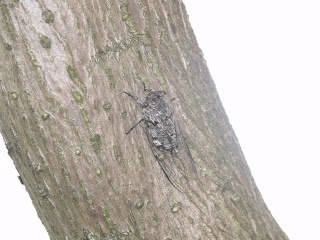Infelizmente a estação das cigarras está chegando ao fim aqui no Brasil!! Isso significa pelo menos cinco meses de inatividade (de abril a setembro, que é quando as cigarras voltam a emergir por essas bandas). Talvez esse seja meu último post até lá, por isso mesmo procurei tirar as melhores fotos possíveis, assim como uma das melhores filmagens também, na minha humilde opinião (não tenho curso de fotografia, fotografo por puro instinto e pura diversão mesmo). Mais um post da "cigarra camuflada", só que dessa vez removi a camuflagem de suas costas para revelar a tradicional marca em "M" no mesonoto, tão presente no gênero Tibicen (e em alguns outros gêneros também). Mas não é só pelo mesonoto que eu acho isso: é pelo formato geral do corpo, em especial o formato da cabeça, com olhos saltados e "nariz" achatado, e também pelo canto, similar ao das demais espécies do gênero. Mas eu não sou biólogo, portanto não posso afirmar categoricamente que é isso ou não. Mas é o que eu acho. Talvez eu tenha que aguardar até a próxima temporada de cigarras para saber se estou certo ou não, mas não faz mal. Deixo aqui meu registro para a avaliação do leitor. E até a próxima temporada!
Unfortunately the cicada season is coming to an end here in Brazil! That means at least five months of inactivity (April to September, which is when the cicadas emerge again around here). That may be my last post till then, so that's why I've tried to take the best pictures i could, and also one of the best videos, in my humble opinion (I have no photography course, i shoot by pure instinct and pure fun at all). Another post of "camouflaged cicada", but this time i removed the camouflage from its back to reveal the traditional "M" mark on the mesonotus, as it presents itself on genus Tibicen (and in some other genres as well). But not only because of the "M" mark I think it's a Tibicen: it's the body shape, especially the shape of the head, with bulging eyes and "nose" flat, and also the song, similar to the other species. But I'm not a biologist, so I can not say categorically that it is or it is not. But that's what I think. I may have to wait until next season for cicadas to know if I'm right or not, but nevermind. I leave here my record for the evaluation of the readers. And until next season!




































